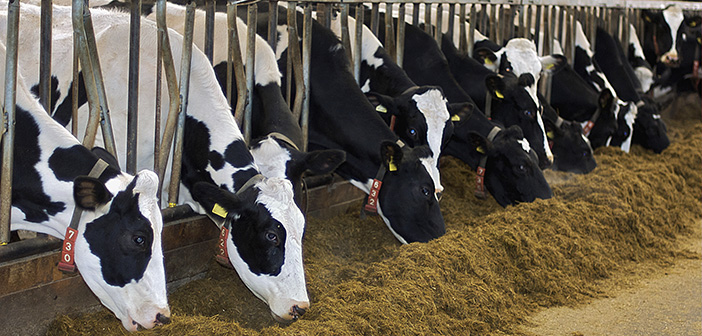With good silage availability on many farms across the country, the focus turns to the variable quality being experienced from region to region, and even farm to farm, warns animal feed wholesaler Trident.
The company is advising that correctly complementing forage quality will be key to dairy farmers maximising rumen efficiency and performance.
Many farms have adequate levels of silage filling clamps this winter, but the opportunity to maximise milk from forage, to increase margin per litre, relies heavily on good ration formulation.
Trouw Nutrition analysis results for grass silages show that averages for protein are quite good although lower than last year’s averages (14.3-14.9% CP), and there is considerable variation with results ranging from 5.7% up to 22.1% CP.
“It is vital to ensure farmers are balancing ‘their’ forage rather than the ‘average’ forage, or they will lose out on milk,” said Charlotte Ward, ruminant technical manager at Trident.
“Average energy (10.7 to 11.4MJ ME/kg DM) values are generally good, with higher values seen in the earlier cuts, but again there is variation between cuts, within cuts, within individual clamps and across different farms.”
Trouw shows energy values ranging between 9.1 to 12.2 ME/kgDM, and Ms Ward added: “What that means in practical terms, is if a cow eats 10kgs DM from forage and the farmer overestimates the energy the forage supplies by 2MJ/kgDM, this means they will be 20MJ short in their ration. That equates to a loss of over 3.5 litres of milk, because they haven’t analysed their forage to understand their energy base.”
Ms Ward believes many farms are going to struggle with intakes, whether at the overly dry or overly wet, acidic ends of the spectrum. Average dry matters are generally higher than last year (around 35%), so improving palatability is going to be vital.
A number of this year’s grass silages also contain very high levels of lignin, with even early first cuts averaging over 33%, meaning it will be much harder for the rumen microbes to break down the silage fibre, which will slow digestion, cut passage rates and further restrict intakes.
Additional fermentable energy
On average the NDF levels in this year’s grass silages are normal, but the higher lignin levels mean this fibre is less digestible, so silage may not feed as well as it should on paper.
“What’s needed is additional quickly fermentable energy (FME) to boost microbial activity in the rumen, aiming for a mix of starch and sugars (minimum of 5% sugars on a DM basis) and an ideal starch:sugar ratio of 3:1,” Ms Ward said.
Good options to consider include more rumen-friendly starch sources like caustic treated cereals and ground maize, or more balanced feeds like biscuit meals, which contain starch, sugars and oil.
For sugars, she recommends one of the high sugar liquid feeds. Liquid feeds will also balance the high dry matter of many silages, ensuring the final ration is not too dry, typically aiming for 45% DM. This will minimise sorting whilst maximising intakes.
“Liquid feeds are great for increasing ration palatability, boosting intakes and binding the various ration ingredients together,” Ms Ward said. “The result is not only a higher intake of nutrients overall, but a more consistent intake that further improves rumen efficiency and milk from forage in particular.”
Spreading energy supply
Using a selection of feeds to provide the necessary extra fermentable energy (FME) will also spread the rate of release in the rumen. This is critical to drive and support fibre breakdown, as well as capture and efficiently utilise the rumen degradable protein (RDP) in some of this year’s grass silages.
This is especially true where grass silage is the only or predominant forage in the ration, increasing the risk of excess nitrogen in the rumen. As well as representing a loss of valuable nutrients, excreting this nitrogen requires energy that could otherwise be used for milk production.
Protein
The other factor to consider is the source of rumen-bypass protein (digestible undegraded protein, DUP) in the ration.
NovaPro is a xylig-treated British rapeseed expeller, which supplies similar levels of DUP to soya, with considerably less cost and a lower environmental impact. In rations with high levels of RDP coming from high protein grass silage, using NovaPro in the ration can help to improve nitrogen efficiency and reduce nitrogen pollution.
Where additional rumen degradable protein is needed to balance low crude protein silages, Ms Ward advises to look to high protein liquids such as Spey syrup, distillers grains and high protein moist feeds.
She added: “If you don’t measure it, you can’t manage it, and going forward with many farmers still trying to recover from the impact of COVID-19 on their milk contracts last year, and more Covid-19 disruptions ahead, it’s never been more important to maximise farm efficiency.”


